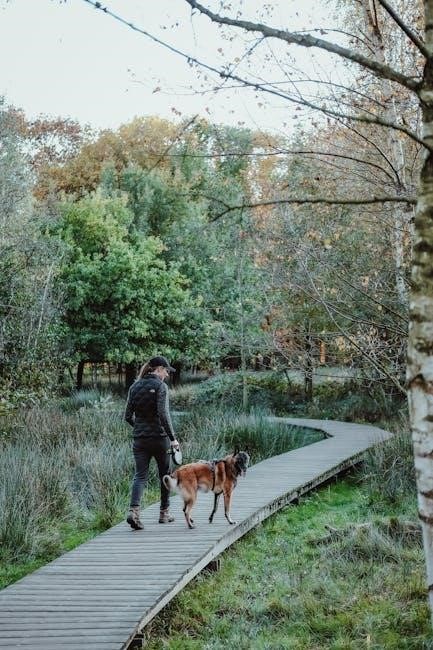Trail Guide to the Body by Andrew Biel is a renowned textbook for anatomy and palpation, offering detailed illustrations and practical guidance for bodywork professionals and students.
Overview of the Book and Its Importance
Trail Guide to the Body by Andrew Biel is a comprehensive guide to musculoskeletal anatomy, designed for hands-on learning. It provides detailed illustrations and clear instructions for locating muscles, bones, ligaments, and bony landmarks, making it indispensable for massage therapists, physical therapists, and bodywork professionals. The book is celebrated for its user-friendly approach, combining visual and tactile learning to master palpation skills. Its importance lies in its ability to bridge theory and practice, offering a foundational resource for both students and practitioners in the field of manual therapy and healthcare.
Target Audience and Applications
Trail Guide to the Body is primarily designed for massage therapists, physical therapists, sports trainers, and students of bodywork modalities. It serves as an essential tool for hands-on learning, enabling professionals to accurately locate and assess musculoskeletal structures. The book is widely used in educational settings, including massage and therapy schools, and is a recommended resource for licensing and certification exams. Its detailed illustrations and practical guidance also make it invaluable for yoga instructors, occupational therapists, and healthcare professionals seeking to deepen their understanding of human anatomy and manual therapy techniques.
Author Background: Andrew Biel
Andrew Biel is a licensed massage practitioner and educator, having taught at institutions like Boulder College of Massage Therapy and Seattle Massage School. His work has been recognized with the Massage Therapy Foundation’s Humanitarian Award, reflecting his dedication to advancing the field of bodywork and anatomy education.
Professional Experience and Contributions

Andrew Biel, a licensed massage practitioner, has extensive experience in education and bodywork. He has taught at Boulder College of Massage Therapy and Seattle Massage School, and led Cadaver Studies for Bodyworkers at Bastyr Naturopathic University. His work emphasizes practical anatomy and palpation, making complex concepts accessible. Biel’s contributions to the field have been recognized with the Massage Therapy Foundation’s Humanitarian Award in 2011, highlighting his dedication to advancing massage therapy education and practice.
Other Notable Works and Awards
Andrew Biel is also known for his award-winning book, Trail Guide to Movement, which complements his anatomical expertise. He received the Massage Therapy Foundation’s Humanitarian Award in 2011 for his contributions to the profession. Biel’s books are highly acclaimed, with Trail Guide to the Body becoming a gold-standard textbook in anatomy education. His work is praised for its clarity and practicality, making it indispensable for students and professionals alike. These contributions underscore his commitment to advancing the understanding of human anatomy and bodywork practices.
Key Features of Trail Guide to the Body
Trail Guide to the Body features 945 detailed illustrations, covering 162 muscles, 206 bones, 33 ligaments, and 110 bony landmarks. Its spiral-bound design and digital resources enhance hands-on learning.
Illustrations and Anatomical Details
Trail Guide to the Body features 945 detailed illustrations, covering 162 muscles, 206 bones, 33 ligaments, and 110 bony landmarks. These visuals provide a clear, precise map of the musculoskeletal system, aiding learners in mastering palpation and manual therapy skills. The book’s spiral-bound design allows for easy reference during hands-on practice. Its user-friendly layout and high-quality images make complex anatomy accessible, ensuring accurate identification of structures. This comprehensive visual guide is indispensable for students and professionals in bodywork and healthcare fields.
Palpation Techniques and Hands-On Learning
Trail Guide to the Body excels in teaching palpation techniques through clear, step-by-step instructions and visual guides. It helps learners accurately locate muscles, bones, and other structures, essential for manual therapy. The book’s practical approach makes mastering palpation skills engaging and accessible. Videos and additional resources complement the text, enhancing hands-on learning. This focus on tactile exploration ensures students and professionals can confidently apply their knowledge in real-world settings, making it a cornerstone for bodywork education and licensing preparation.

Editions and Updates
Trail Guide to the Body has evolved through multiple editions, with each update enhancing content, illustrations, and features to meet the needs of students and professionals.
Evolution of the Book Through Editions
Trail Guide to the Body has undergone significant updates since its first publication, with each edition refining content and expanding its scope. The 6th edition introduced enhanced illustrations, covering 162 muscles, 206 bones, and 33 ligaments, providing unparalleled anatomical detail. Earlier editions laid the groundwork, but the latest version incorporates digital resources, palpation videos, and interactive tools, making it a comprehensive learning resource for anatomy and palpation. These updates reflect Andrew Biel’s commitment to advancing anatomical education for students and professionals.
New Additions in the Latest Edition
The 6th edition of Trail Guide to the Body introduces enhanced illustrations, now covering 162 muscles, 206 bones, 33 ligaments, and 110 bony landmarks. It includes new palpation techniques and expanded digital resources, such as interactive apps and video tutorials, to aid hands-on learning. These additions provide students and professionals with a more immersive and accessible way to master surface anatomy and manual therapy skills. The latest updates reflect Andrew Biel’s dedication to creating a comprehensive and modern anatomical learning tool.

Trail Guide to the Body Student Workbook
The Trail Guide to the Body Student Workbook complements the textbook with practice exercises, quizzes, and interactive tools, helping students apply anatomical knowledge effectively through hands-on learning.
Practice Exercises and Study Tools
The workbook provides an array of practice exercises, including labeling activities and multiple-choice quizzes, designed to reinforce understanding of musculoskeletal anatomy. Interactive tools, such as palpation videos and overlay images, enhance student engagement, allowing them to visualize and apply concepts effectively. These resources work seamlessly with the textbook, ensuring a comprehensive learning experience tailored to bodywork professionals and students aiming to master surface anatomy and palpation techniques.
Interactive Resources and Digital Support
Trail Guide to the Body offers extensive digital support, including palpation technique videos and interactive 3D models. These tools provide visual and hands-on learning opportunities, enhancing comprehension of anatomical structures. Accessible online, these resources allow students to study at their own pace, reinforcing textbook content with dynamic visuals. The integration of technology ensures a modern, engaging approach to mastering surface anatomy and musculoskeletal palpation, making it an invaluable resource for both students and professionals in bodywork fields.

Use in Educational Settings
Trail Guide to the Body is widely adopted in massage, physical therapy, and occupational therapy schools. It is a core textbook for anatomy and palpation training, preparing students for licensing exams and professional practice. Its clear illustrations and hands-on approach make it an essential resource for classrooms and clinical settings, ensuring students gain a deep understanding of musculoskeletal anatomy.
Adoption in Massage and Therapy Schools
Trail Guide to the Body is a cornerstone in massage and therapy education, widely adopted by schools worldwide. Its detailed illustrations and spiral-bound design make it a practical tool for daily use. Faculty endorse it for its clarity in teaching musculoskeletal anatomy and palpation techniques. The book aligns with curriculum needs, bridging classroom learning and clinical practice. Students praise its user-friendly format, while instructors value its comprehensive coverage. It is often integrated into required coursework, ensuring future professionals gain the foundational skills necessary for successful careers in bodywork and therapy.
Role in Licensing and Certification Tests
Trail Guide to the Body is a required textbook for state licensing exams in massage therapy, endorsed by the National Certification Board for Therapeutic Massage and Bodywork. Its detailed illustrations and clear instructions on palpation and anatomy provide students with the essential knowledge needed to excel in certification tests. Many professionals credit the book for helping them master the musculoskeletal system, making it a vital resource for passing licensing examinations and achieving professional certification in bodywork and related fields.
Customer Reviews and Testimonials
Customers praise Trail Guide to the Body for its clear, detailed content and essential role in licensing exams, making it a top choice for anatomy learning.
Feedback from Students and Professionals
Students and professionals widely praise Trail Guide to the Body for its clarity and depth. Many describe it as “wonderful” and “very thorough,” emphasizing its ease of use.Massage therapy students highlight its essential role in mastering anatomy, while professionals applaud its practicality for clinical applications. The book’s detailed illustrations and clear explanations make complex concepts accessible. Users also appreciate the accompanying digital resources, which enhance learning. Overall, the textbook is celebrated as an indispensable tool for both education and professional practice in bodywork and healthcare fields.
Success Stories and Recommendations
Many students credit Trail Guide to the Body for helping them excel in anatomy courses and pass licensing exams. Professionals recommend it for its clear, precise guidance, enhancing clinical practices. The book’s detailed illustrations and practical approach make it a top choice in educational settings. Its effectiveness in teaching palpation and musculoskeletal anatomy has made it a staple in many therapy and massage programs, ensuring its continued popularity among both students and experienced practitioners.
Trail Guide to the Body by Andrew Biel stands as a cornerstone in anatomy education, renowned for its clarity and comprehensive coverage. Its detailed illustrations and hands-on approach have made it indispensable for students and professionals alike. Widely adopted in educational programs and trusted for licensing exams, this book has proven its value time and again. With each edition, it continues to evolve, solidifying its role as a gold-standard resource for understanding the musculoskeletal system. It remains an essential tool for anyone committed to mastering human anatomy and palpation techniques.